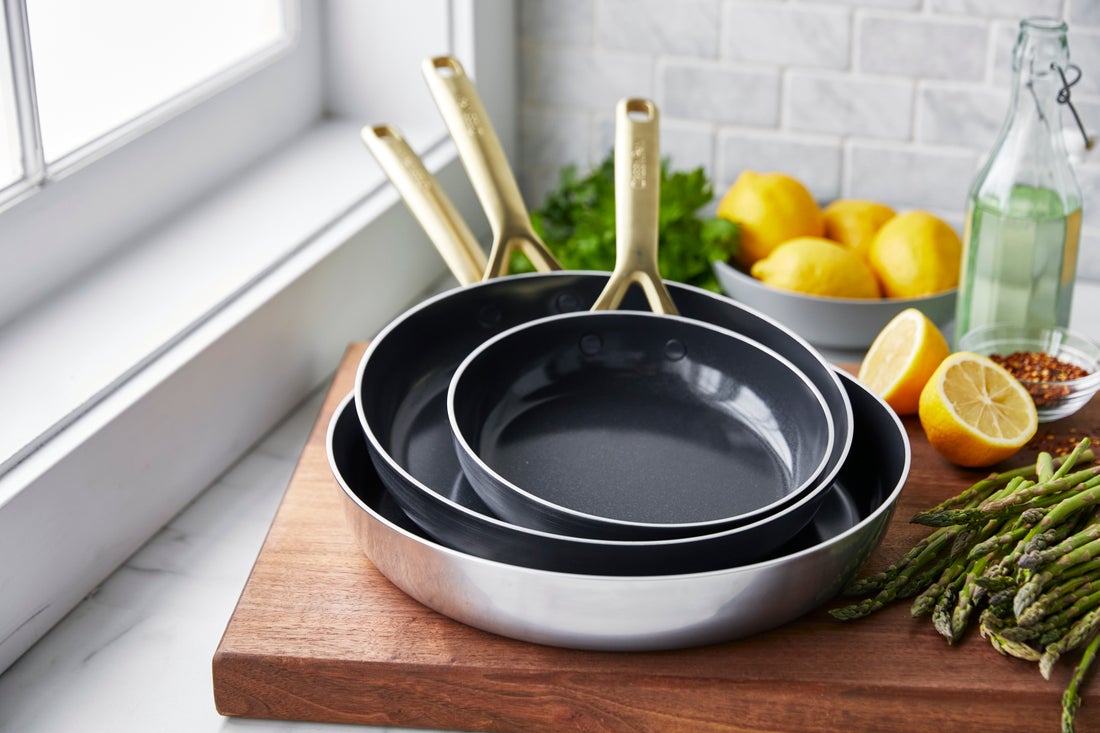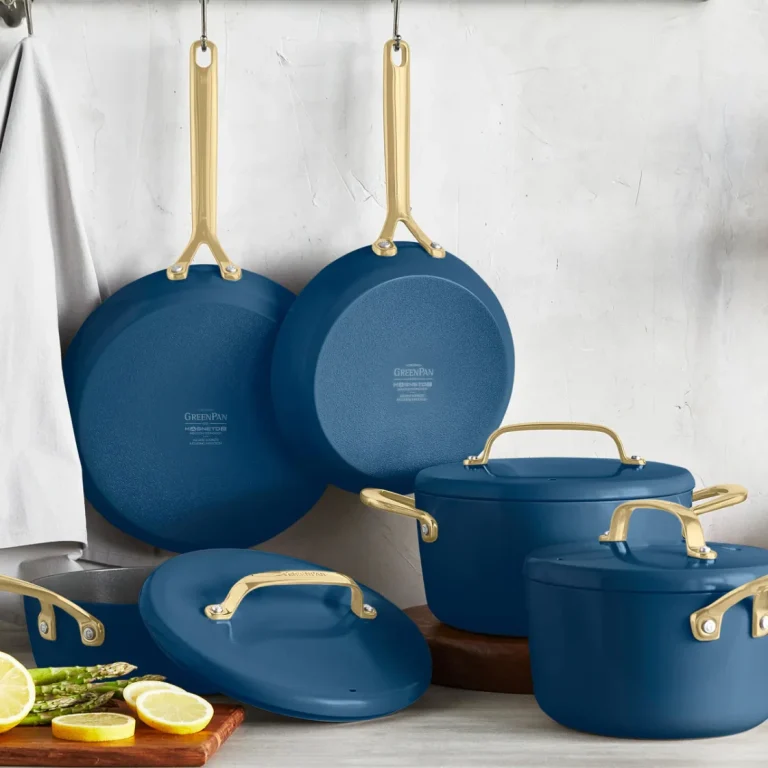Imagine cooking your favorite meal with the peace of mind that you’re using safe cookware. You might have heard about ceramic pans and their reputation for being non-toxic.
But how can you be sure? This is an important question, especially if you care about your health and the environment. You want to know if ceramic pans are truly as safe as they claim to be. With so many products on the market, choosing the right cookware can be overwhelming.
Are these pans really free from harmful chemicals? Do they live up to their promises? We’ll dive into the truth behind ceramic pans, exploring their materials and benefits. By the end, you’ll have a clear understanding of whether ceramic pans deserve a spot in your kitchen. Let’s unravel the mystery together.

Credit: www.amazon.com
Ceramic Pans Overview
Ceramic pans have gained popularity for their perceived safety. Many people choose them for their non-toxic properties. But, are they truly safe? Let’s delve into the basics of ceramic pans.
Ceramic Coating Process
Ceramic pans start with a metal base. It’s usually aluminum or stainless steel. The ceramic coating is applied on this base. This coating is made from natural minerals. The minerals are baked into a solid layer. This creates a smooth surface. It’s known for its non-stick properties. This process doesn’t involve harmful chemicals.
Benefits Of Ceramic Pans
Ceramic pans offer several benefits. They are free from PTFE and PFOA. These chemicals are found in traditional non-stick pans. Ceramic pans are also heat resistant. They can withstand high temperatures without releasing toxins. Their surface is easy to clean, reducing the need for harsh detergents. This makes them a sustainable choice.
Many people are concerned about the environment. Ceramic pans align with eco-friendly values. Their production is less harmful. The materials used are naturally sourced. This minimizes environmental damage. They are also long-lasting. This reduces waste over time.
Considerations When Buying
Some ceramic pans may have mixed coatings. Always check labels for added substances. Pure ceramic pans are safe. Consider your cooking habits and stove type. High-quality ceramic pans work well on all stoves. Ensure the pan suits your needs before purchasing.
Manufacturing Process
Ceramic pans are considered non-toxic due to their natural coating. Unlike traditional non-stick pans, they don’t contain harmful chemicals like PFOA or PTFE. This makes them a safer choice for health-conscious cooks.
The manufacturing process of ceramic pans is a fascinating journey that plays a crucial role in their non-toxic reputation. Understanding how these pans are made can help you make informed decisions for your kitchen. Let’s explore how the materials and coating techniques contribute to the safety and quality of ceramic cookware.Materials Used
Ceramic pans are primarily made from natural materials, which adds to their non-toxic appeal. The core material is usually a type of clay, known for its heat resistance and even heating properties. This clay is mixed with water and other minerals to create a strong base for the pan. Manufacturers often use eco-friendly materials, avoiding harmful chemicals that can leach into food. This means you can cook with peace of mind, knowing your meals are free from toxins. It’s worth checking labels to see if your ceramic pan is made with these safe materials.Coating Techniques
The coating technique is what gives ceramic pans their non-stick properties. A silica-based gel is often used, which is derived from sand and offers a smooth cooking surface. Unlike traditional non-stick pans, ceramic coatings do not contain PTFE or PFOA, chemicals that can be harmful when heated. During the coating process, multiple layers are applied to ensure durability and effectiveness. This creates a robust surface that is resistant to scratches and stains. Have you ever noticed how easy it is to clean your ceramic pan? That’s the result of these advanced coating techniques. Manufacturers are continually innovating to enhance the quality of these coatings, ensuring they remain a safe choice for your kitchen. When choosing a ceramic pan, consider how the coating might affect your cooking experience and longevity of the pan. The manufacturing process of ceramic pans combines natural ingredients with thoughtful design. By understanding these elements, you can better appreciate why ceramic pans are considered a non-toxic option for your cooking needs. Are you ready to make the switch to ceramic cookware in your kitchen?Safety Claims
Ceramic pans often boast about their safety features. Many people wonder if these claims hold true. The term “non-toxic” draws attention. It promises safer cooking for families. But what makes ceramic pans stand out? Let’s explore their properties and how they compare with other cookware.
Non-toxic Properties
Ceramic pans are free from harmful chemicals. They do not contain PFOA or PTFE. These are common in traditional non-stick pans. Ceramic coatings come from natural materials. They offer a safer cooking surface. No toxic fumes are released during cooking. This makes them a popular choice for health-conscious cooks.
Comparison With Other Cookware
Ceramic pans differ from Teflon and aluminum. Teflon can release harmful fumes at high heat. Aluminum may leach into food. Cast iron requires special care to prevent rust. Stainless steel can be tricky for non-stick cooking. Ceramic pans avoid these issues. They offer a simpler and safer option. The non-stick surface makes cleaning easy. This adds to their appeal in busy kitchens.
Common Misconceptions
Many believe ceramic pans are entirely non-toxic. But some may contain harmful chemicals if not properly manufactured. Always verify the pan’s safety standards before purchase to ensure a truly non-toxic choice.
Ceramic pans have become a popular choice for many health-conscious cooks. However, there are several common misconceptions about their safety and functionality. Some people are skeptical about whether these pans are truly non-toxic. Understanding the truth behind these misconceptions can help you make informed decisions in your kitchen. ###Clarifying Myths
You might have heard that ceramic pans are entirely free of any harmful chemicals. While they are generally safer than some non-stick options, it’s essential to know that not all ceramic pans are created equal. Some contain a mix of materials that may not be entirely free of toxins. Think about the last time you bought a ceramic pan. Did you check if it was 100% ceramic or just ceramic-coated? The latter can sometimes chip, exposing underlying materials that might not be as safe. Are you one of those who believe that ceramic pans never stick? While they are known for their non-stick properties, improper use or overheating can still lead to food sticking. Proper care and usage are key to maintaining their non-stick qualities. ###Understanding Risks
The risk of toxins leaching from cookware is a significant concern for many. Ceramic pans, when truly made from pure ceramic, are less likely to release harmful substances. However, if a ceramic pan is merely coated, the underlying materials could pose risks if the coating wears off. Consider the potential risk of using scratched or damaged pans. Have you ever continued to use a pan with visible wear and tear? It’s crucial to replace any cookware that shows signs of damage to avoid potential health risks. One common worry is the presence of lead or cadmium in ceramic cookware. High-quality brands are tested to ensure they are lead and cadmium-free. Always look for labels or certifications that guarantee these safety standards before purchasing. Being aware of these misconceptions and risks allows you to use ceramic cookware confidently. Have you ever questioned the safety of your cookware? Understanding the facts can ease your concerns and help you cook with peace of mind.Scientific Studies
Scientific studies explore if ceramic pans are truly non-toxic. Many believe these pans are safer than traditional non-stick options. Researchers examine materials and coatings to ensure health safety.
Ceramic pans are often advertised as the safer, non-toxic alternative to traditional cookware. But what do scientific studies reveal about their safety? Understanding the research is crucial for anyone concerned about the health implications of their kitchen choices.Research Findings
Scientific studies have investigated the materials and coatings used in ceramic pans. Researchers have analyzed whether these substances release harmful chemicals when heated. A study conducted by the Environmental Health Institute found that ceramic coatings, unlike Teflon, do not produce toxic fumes even at high temperatures. Another research focused on the leaching of heavy metals from ceramic cookware. Tests showed minimal leaching, indicating that ceramic pans are generally safe for everyday cooking. However, the quality of ceramic pans can vary, affecting their safety profile. How can you ensure your ceramic pans are the safest option?Expert Opinions
Experts emphasize the importance of quality when choosing ceramic pans. Dr. Linda Jameson, a toxicologist, advises consumers to invest in reputable brands that adhere to safety standards. She warns against cheap, poorly made ceramic pans, which might contain harmful additives. Cooking experts also highlight the need to care for your ceramic pans properly. Chef Alex Turner suggests avoiding abrasive cleaning tools that could damage the ceramic coating and potentially release harmful particles. Have you been maintaining your ceramic pans correctly? In conclusion, scientific studies provide reassuring evidence regarding the safety of ceramic pans, especially when quality and care are prioritized. Always question the choices you make in your kitchen, ensuring they align with your health and safety goals.Consumer Experiences
Curious about ceramic pans’ safety? Many believe ceramic pans are non-toxic. They’re free from harmful chemicals like PFOA and PTFE. Cooking enthusiasts value their eco-friendly nature and durability.
Consumer experiences can provide valuable insights into whether ceramic pans are truly non-toxic. While manufacturers promote their products as safe, real-world usage often reveals whether they live up to their claims. Here, we dive into testimonials and practical applications, offering you a clearer picture of ceramic pans from those who have used them in their own kitchens.Testimonials
Consumers often share their experiences online, giving you a firsthand account of how ceramic pans perform. Many praise their non-stick capabilities, claiming eggs slide off effortlessly. Others appreciate the absence of harsh chemicals like PTFE and PFOA in the coating. However, not everyone is satisfied. Some users report the non-stick surface diminishes over time, requiring more oil to cook. These varied testimonials highlight the importance of researching before purchasing.Real-world Usage
In everyday kitchens, ceramic pans are tested beyond manufacturer claims. You might wonder how they fare with constant use. Some users say they clean up easily after cooking sticky sauces. This ease of cleaning is a significant advantage for busy households. But there’s a catch. Frequent use can lead to wear and tear. A friend of mine found her ceramic pan chipped after a year of daily use, questioning its durability. Are you willing to replace your cookware regularly for the sake of safety? Would you sacrifice longevity for health benefits? As you consider purchasing ceramic pans, these real-world insights can guide your decision, ensuring you choose cookware that aligns with your priorities.Environmental Impact
Ceramic pans are popular for their non-toxic reputation. But their environmental impact deserves attention too. Understanding how these pans affect our planet is crucial. Let’s explore the sustainability and eco-friendly practices associated with ceramic pans.
Sustainability
Ceramic pans are made from natural materials. This makes them more sustainable than other cookware. These materials decompose naturally without harming the environment. The production process also uses less energy. This reduces the carbon footprint significantly. Ceramic pans last longer, reducing waste over time. They are a sustainable choice for conscious consumers.
Eco-friendly Practices
Manufacturers focus on eco-friendly practices in producing ceramic pans. Many use renewable energy sources in their factories. This helps in reducing greenhouse gas emissions. They also aim for minimal waste during production. Recycling and reusing materials is a common practice. This commitment to the environment makes ceramic pans a responsible choice.
Care And Maintenance
Caring for ceramic pans ensures they remain non-toxic and efficient. Proper care extends their lifespan. Proper maintenance keeps them looking good and functioning well.
Proper Cleaning
Cleaning ceramic pans correctly is vital for safety. Use gentle soap and warm water. Avoid harsh abrasives or steel wool. They scratch and damage the ceramic surface. A soft sponge works best. Clean pans immediately after use. This prevents food from sticking. Dry them thoroughly with a soft cloth. Water spots can discolor the surface.
Extending Lifespan
Careful use extends the life of ceramic pans. Use wooden or silicone utensils. Metal utensils cause scratches. Heat the pan gradually. Avoid high flames that overheat the surface. Store pans properly. Stack them with a cloth or pad between each pan. This prevents scratching. Avoid putting them in the dishwasher. Handwashing preserves their non-toxic coating.
Choosing The Right Pan
Finding a non-toxic ceramic pan can be tricky. Not all pans are made equal. Some may have hidden chemicals. It’s important to know what to look for. This ensures you make a safe choice. Let’s explore how to choose the right pan.
Factors To Consider
First, check the materials. True ceramic pans should be free from PTFE and PFOA. These chemicals can be harmful. Make sure the pan is 100% ceramic. Some are only ceramic-coated.
Next, think about the coating. A good coating is smooth and even. This helps food cook better. It also makes cleaning easier. Look for pans with a thick coating. They last longer and resist scratches.
Weight is another factor. Heavier pans distribute heat more evenly. But they can be hard to handle. Choose a weight that feels comfortable to you.
Top Brands
Several brands offer quality ceramic pans. GreenPan is well-known for its non-toxic options. Their pans are free from harmful chemicals. They offer a range of sizes and styles.
Caraway is another trusted brand. They focus on safety and design. Their pans come in stylish colors and are easy to use.
Xtrema offers fully ceramic pans. They are durable and toxin-free. Xtrema is a good choice for those seeking true ceramic.
Consider these brands when shopping. They provide safe and effective options. Choose the one that fits your needs best.

Credit: www.amazon.com

Credit: www.organicauthority.com
Frequently Asked Questions
Is Ceramic Cookware Really Non-toxic?
Ceramic cookware is generally considered non-toxic. It’s free from harmful chemicals like PTFE and PFOA. Always choose high-quality ceramic brands to ensure safety. Proper care extends its non-toxic properties. Avoid using metal utensils to prevent surface damage. Keep your ceramic cookware in top condition by following manufacturer guidelines.
What Is The Least Toxic Cookware?
Cast iron, stainless steel, and glass are the least toxic cookware options. These materials are safe and durable. They do not leach harmful chemicals into food during cooking, ensuring healthier meals. Choose high-quality brands to guarantee purity and safety. Always follow care instructions to maintain their non-toxic properties.
What Are The Negatives Of Ceramic Pans?
Ceramic pans can wear out quickly and scratch easily. They may require frequent replacement. High heat can damage the non-stick surface. Some cheaper options might contain harmful chemicals. Proper care is essential to maintain their quality. They often have a higher initial cost than other materials.
Do Ceramic Pans Leach Into Food?
Ceramic pans are generally safe and do not leach harmful chemicals into food. They offer a non-toxic cooking surface. Ensure your pan is truly ceramic and not just coated with ceramic for maximum safety. Always follow manufacturer guidelines to maintain quality and avoid damage.
Conclusion
Ceramic pans offer a safer cooking choice for many households. They are generally non-toxic, providing peace of mind during meal preparation. The natural materials used in ceramic pans reduce harmful chemicals. It’s essential to choose high-quality ceramic pans for safety.
Regular maintenance can extend their lifespan and keep them effective. While ceramic pans are safer, they may not be the best for all cooking styles. Consider your cooking needs before making a purchase. Explore different brands and models to find the right fit.
Ceramic pans can be a valuable addition to your kitchen.


